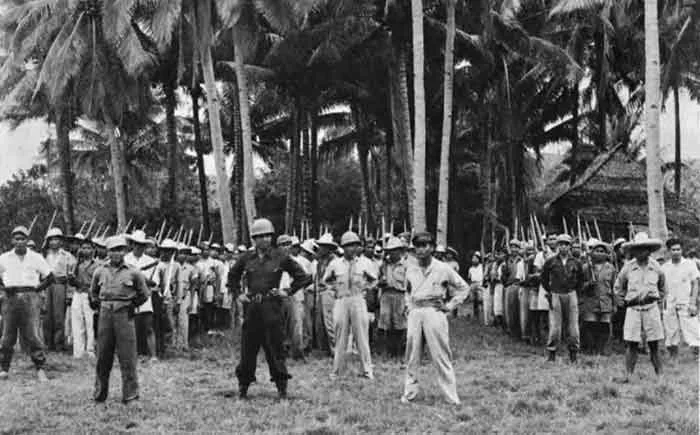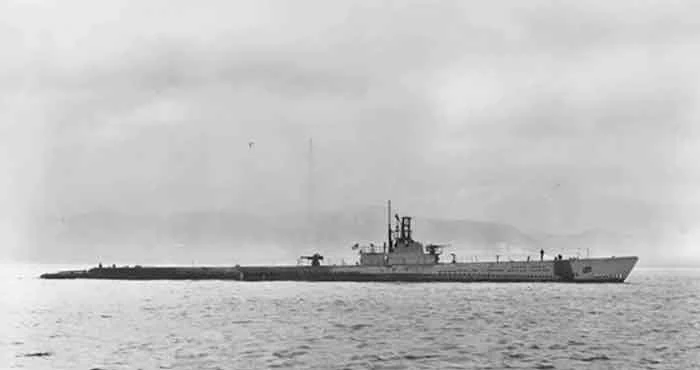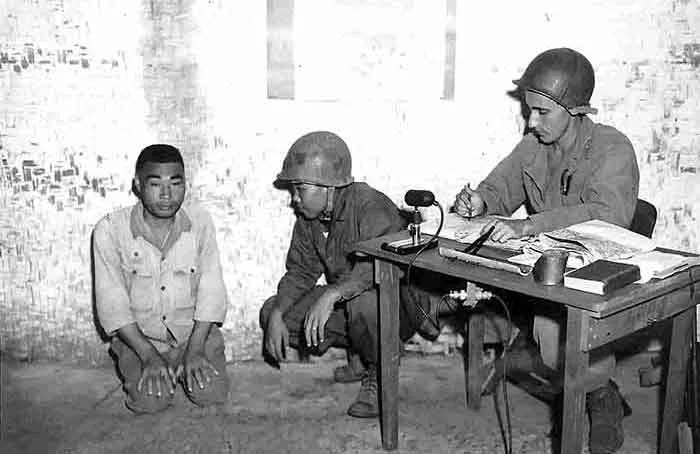Jay D. Vanderpool, the Officer who Unified Guerrillas in Batangas, Cavite and Laguna
After the fall of Bataan and Corregidor in April and May 1942, respectively, Lt. Gen. Jonathan Wainwright, designated commander of all United States Forces in the Philippines after General Douglas MacArthur was ordered to Australia, was forced by the terms of surrender to Japan to issue an order to all American troops in the Philippines to lay down their arms.
While most commanders complied with Wainright’s order, there were those who refused to surrender to the Japanese and went into hiding. Some of these officers and enlisted men – including Filipino personnel with the United States Armed Forces in the Far East (USAFFE) – formed underground or guerrilla movements that would continue to resist the Japanese from their mountain hideouts.
 |
| Left: Col. Vanderpool. Image credit: ARSOF History. Right: Filipino soldiers being inspected. Image credit: US National Archives. |
“Although in theory almost all submitted to SWPA1direction, they quarreled incessantly over questions of local authority, often maintaining competing intelligence nets within each other's jurisdiction2.”
“Although the majority of the guerrillas shared a common antipathy for the Japanese, they were often divided among themselves, separated into intractable rival factions engaged in a bitter struggle for power. There was no established demarcation of authority and no defined chain of command. All reports of returning AIB3agents stressed the necessity of achieving greater cooperation and more unified control among the guerrilla organizations4.”
By June of 1943, the former Philippine Sub-Section of the Allied Intelligence Bureau within the SWPA had been re-designated as the Philippine Regional Section and had started increasing the coordination with guerrilla outfits and the sending of assistance in the form of firearms, ammunition and other necessary wartime supplies. These were primarily sent to the Philippines clandestinely by submarines.
Agents were also being increasingly smuggled into the country to gather intelligence and coordinate guerrilla operations. MacArthur, however, was personally aware of the rivalries that existed between guerrilla groups and had instructed these agents to “follow a policy of general encouragement without direct command interference which might incur resentment5.”
The long-term solution found by the SWPA to address the factionalism among guerrilla outfits in the Philippines, however, was to reactivate the so-called Philippine Military District administrative system. The system had a legal precedent and thought to be “the most acceptable method of division to the majority of de facto guerrilla leaders6.”
As per this system, Batangas belonged to the 4thMilitary District with Manila, Cavite, Laguna and Mindoro.
Because the Japanese Imperial Army set up and maintained so much fewer garrisons in the Visayas and Mindanao as they did in Luzon, invariably Allied intelligence agents were initially sent to the south where they could operate with lesser risk of discovery.
The first attempt at penetrating District 4 was in October of 1943, when Major Lawrence H. Phillips and a group of agents were sent to Mindoro. Despite its size, the island was only lightly garrisoned by the Japanese. Phillips’ mission was to set up a radio station that could directly communicate with SWPA headquarters in Australia and also to establish contacts in Manila.
Because of Mindoro’s proximity to Batangas, Phillips and company also started liaising with guerrilla outfits operating in the latter province. Among these was the so-called Rainbow Regiment, an organization that would later gain official recognition from the United States Army. In the outfit’s organizational history, it was noted that Phillips had provided the guerrillas Australian grenades as well as “cigarettes and chocolates with I Shall Return – MacArthur” printed on the cover7.
Phillips would successfully set up a radio station at Cape Santiago in Calatagan with the help of a guerrilla outfit commanded by one Emilio Macabuag8. In February the following year, however, Phillips would be caught and executed by the Japanese in his hideout at Mt. Calavite “after a futile attempt to escape9.”
Phillips’ execution did not end SWPA’s clandestine operations in District 4. By July that same year, US Navy Reserves Commander George F. Rowe was sent to replace him in Mindoro. Rowe would re-establish radio contact between SWPA and Mindoro, which would become “an easily accessible and reliable outlet for Luzon intelligence” until the arrival later that year of another agent who would be assigned to operate in Batangas, Cavite and Laguna.
By mid-1944, SWPA was prepared to step up agent penetrations in Luzon for direct coordination with guerrilla commanders in the island. To be able to do this, what was needed was a core of specially trained and equipped parties of officers. Thus, SWPA sent a dispatch to each United States Army division operating in the area “to nominate an officer of field grade rank for a hazardous mission10.”
One of the volunteers who responded to the call in September 1944 was a Major John “Jay” D. Vanderpool, at that time part of the intelligence section of the 25thInfantry Division based in New Caledonia. He was a self-made officer, having risen through the ranks.
Born in the small town of Wetumka in the state of Oklahoma in 1917, Vanderpool enlisted into the Army in 1936 with a high school diploma. As an enlisted man, he reached the rank of staff sergeant with the Field Artillery and then attended officer candidate school to earn himself a reserve commission as a 2ndLieutenant in 1941. He was with the 8thField Artillery Battalion based in Hawaii when the Japanese attacked Pearl Harbor and also participated in the famous Battle of Guadalcanal11.
To prepare for their insertion into Luzon, Vanderpool and other volunteers had to undergo intensive training. In October 1944, he and other agents boarded the attack submarine USS Cero and made for the Philippines. Vanderpool was originally supposed to be inserted into the guerrilla group of Col. Russell Volckmann in Northern Luzon, but heavy Japanese activity in the rendezvous point forced SWPA to divert his group to the camp of Lt. Col. Bernard Anderson.
From Anderson’s camp in Eastern Luzon, Vanderpool went on “a hazardous journey, hiding in churches and slipping past Japanese patrol boats on Laguna de Bay12” to be able to reach the camp of the Hunters-ROTC guerrilla organization at the time operating in the western Batangas town of Nasugbu.
The timing of Vanderpool’s arrival in Luzon was of the utmost importance to the grand scheme of things as far as the liberation of the Philippines was concerned. By the time he landed on Luzon on the 2ndof November, Allied forces had already established a foothold in Leyte.
From Leyte, MacArthur and his staff were already planning the establishment of a base in Mindoro from which aerial forays could be launched to soften Luzon up for eventual invasion early in 1945. Because of Vanderpool’s presence in Nasugbu, there were among guerrilla commanders in Batangas those who believed a landing in Batangas was imminent – a correct deduction, as subsequent events would show.
Why Vanderpool initially joined the camp of the Hunters-ROTC instead of any other guerrilla outfit in southern Luzon was probably because the Philippine Regional Section thought highly of the group, commanded by ex-Philippine Military Academy cadet Eleuterio Adevoso. Many within the organization “had been sergeants or officers in the Philippine Scouts and the rest, cadets in the Filipino military academy13.” Vanderool did live with other guerrilla outfits as a matter of security to avoid capture by the Japanese.
So that the guerrillas with whom he had networked would ultimately become useful to the liberation effort, particularly in southern Luzon, Vanderpool had to first get the different groups to set aside the petty jealousies that had plagued the guerrilla movement practically from the time guerrilla groups were first formed. His credentials were, indeed, impressive – foremost of which was direct contact with no less than General MacArthur himself.
In an initial memorandum addressed to guerrilla commanders in his area of operations, Vanderpool immediately clarified to all that his presence was “for the purpose of coordinating all activities of loyal guerrilla organizations and acting as a liaison officer between the loyal Filipino people and General MacArthur.” He went on to tell the commanders of his desire to personally meet them15.
Such was Vanderpool’s personality that he was able to skillfully persuade “the guerrillas to put aside parochial differences and agendas to support American requirements16.” In his book about the 11thAirborne Division of the United States Army which was so instrumental to the liberation of Batangas, Major Edward Flanagan, Jr. noted that Vanderpool was “beloved by the Filipinos17.”
By late 1944, Vanderpool had successfully welded together the guerrilla outfits in his area of operation into his own General Guerrilla Command. Because Operation Mike Six, otherwise known as the Nasugbu Landing, was already in the works, the guerrillas were being eyed by United States military planners to disrupt Japanese communication lines and conduct ambuscades that would keep Japanese forces away from the landing beaches.
On the 30thof January 1945, Vanderpool issued to guerrilla commanders what was probably the most eagerly awaited memo: attack orders! Among other things, he wrote to guerrilla commanders, “Petty bickering has been stopped by command of every major guerrilla commander contacted. We will fight as one with every man and every organization fighting side by side for the common cause… This headquarters will maintain communication with the American Forces and relay orders via radio or courier… We will attack with the supplies and arms now on hand…”
Such was the impassioned nature of this memo that Vanderpool concluded by saying
“THE DAY OF RECKONING HAS COME. For three long years, the people of the Philippines have been robbed, starved and tortured with inhuman cruelty. In the brief two days of combat following the order to attack, we must [get back] at once for three years of hell from the cruel torture of innocents [by an enemy who] who has settled like a plague upon the freedom-loving People of the Philippines. Every man who has seen his loved ones suffer now has the opportunity to insure that the hated invader shall receive his just reward.
“LET EVERY MAN GO INTO THE FIELD OF BATTLE WITH THE DETERMINATION THAT HE WILL NOT PAUSE FOR REST OR FOOD UNTIL EVERY JAPANESE IN THIS AREA IS DESTROYED!”
Early in the morning of the following day, the United States Eighth Army landed practically unopposed on the beaches of Nasugbu. Vanderpool immediately reported to Gen. Joseph Swing, Commander of the 11thAirborne Division, who “gave him the mission of gathering, organizing, and coordinating all the guerrillas in the Southern Provinces18.”
After the Nasugbu Landing, Vanderpool’s guerrillas would join the 11thAirborne Division in operations at Nichols Field (presently Villamor Air Base) and Fort McKinley (presently Fort Bonifacio). Some would also participate in the daring raid to liberate civilian internees from the POW camp in Los Baños.
By March, with the capital city of Manila having been retaken from the Japanese, Vanderpool’s guerrillas would be joining American forces in operations much closer to home in the liberation of Batangas.
In April 1945, when Batangas was for all intents and purposes liberated from Japanese occupation, Vanderpool was returned to is parent unit, the 25thInfantry Division. In 1947, he would be seconded to the Central Intelligence Group, predecessor of the CIA. In 1951, he put his experiences working with Filipino guerrillas to good use by working with Korean guerrillas in the Korean War.
For his work with Filipino guerrillas in Southern Luzon, including Batangas, Vanderpool was awarded the Legion of Merit by the United States Armed Forces “for exceptionally meritorious conduct in the performance of outstanding services to the Government of the United States during World War II.”
Vanderpool passed away on the 22ndof April 1993 at the age of 76. He was buried at the Arlington National Cemetery in Virginia, U.S.A.
2 “US Army Special Operations in World War II,” By David W. Hogan Jr. published 1958 in Washington D.C, p. 70.
3 The AIB was the Allied Intelligence Bureau, which was under the G-2 or Intelligence unit of the SWPA.
4 “Reports of General MacArthur: The Campaigns of MacArthur in the Pacific, Volume I,” by General MacArthur's General Staff, published 1966 in Washington D.C., U.S.A., p. 302.
5 Ibid, p. 304.
6 Ibid, p. 302.
7 “Organization of the Rainbow Regiment, Malakas Division, AUSA,” Box 258, Entry 1094, Philippine Archive Collection, Record Group 407, United States National Archives, downloaded from Philippine Veteran Association Office.
8 This guerrilla outfit would be later named the “Major Phillips Unit” in honor of the major, who would be caught and executed by the Japanese.
9 Op cit. General MacArthur’s General Staff, pp. 304-305.
10 Op cit. Hogan, Jr., p. 106.
11 “Major Jay D. Vanderpool: Advisor to the Philippine Guerrillas,” by Dr. Michael E. Krivdo, first published 2013 in Veritas Volume 9, online at ARSOF History.
12 Op cit. Hogan, Jr. p. 80.
13 Op cit. Krivdo.
14 Ibid.
15 “Joe Perez Forces, Anderson’s Guerrillas,” File No. 101-15, online at the United States National Archives.
16 Op cit. Krivdo.
17 “The Angels: A History of the 11th Airborne Division 1943-1946,” by Major Edward M. Flanagan Jr., published 1948 in Washington, p. 107.
18 Ibid, p. 106.



